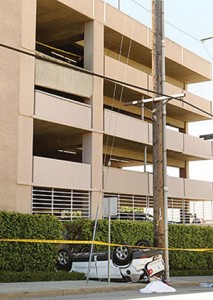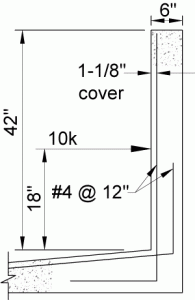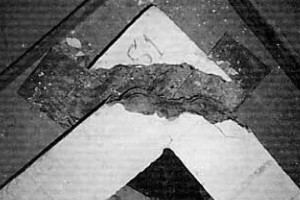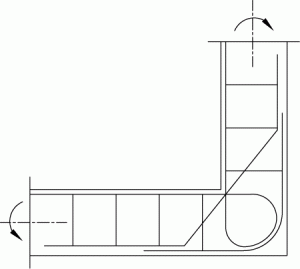Many failures occur in concrete structures because of inadequate detailing of reinforcement in joints and connections. The failures of perimeter vehicular barriers in concrete parking structures offer grim examples where numerous parking patrons have died or have suffered bodily injuries as their vehicles plunged down to the street during the past several years. As an example, Figure 1 shows a cast-in-place concrete barrier wall failure and a subsequent car plunge. Here, the edge of the concrete slab serves as the base of wall and the barrier is termed a wall-slab system.
The perimeter of parking structures and the edges of split ramps in the interior of parking structures are required to have barriers, restraints or guardrails to stop vehicles inside the structure from plunging down. As a general rule, an effective edge barrier should be able to resist a reasonably foreseeable impact loading during the structure’s lifetime. The model building codes prescribe a certain minimum impact load and require that design professionals use their judgment in determining the anticipated load. For example, the International Building Code (IBC) prescribes 10,000 pounds as a minimum ultimate horizontal impact force which all vehicular barrier systems must withstand. The test results show that concrete wall-slab barrier systems do not meet the IBC’s minimum threshold. Due to the design and detailing deficiencies, the barrier systems have failed prematurely, resulting in bodily injuries and fatalities. This article describes the nature of such deficiencies and offers measures that can be taken to remedy the situation.
Figure 1 shows a parking structure located in the City of Los Angeles, CA, where a moving vehicle came in contact with the cantilever barrier wall on its fourth floor. As a result, the wall-slab joint failed in brittle mode and the car plunged down to the street. Subsequently, the driver and sole occupant of the vehicle was fatally injured. Such incidents are not uncommon. Figure 1 shows that the barrier wall system failed at the joint between the vertical wall and horizontal slab, without any cracking or other visible damage to the wall as the result of the car impact. Apparently, the cantilever wall rotated about its base and collapsed because the concrete in the wall-slab joint ruptured in a brittle mode. It showed that the wall-slab joint is the weakest link in the barrier system. The issue is whether the barrier system was capable of resisting the code-prescribed 10,000 pound ultimate impact load. The evidence suggests that it does not have the capacity to resist the prescribed load. Rather, its capacity is about one-fourth of the prescribed load. As such, the barrier system has a significant design deficiency.
Historical Background
The wall-slab barrier design to resist vehicular impact load was first published in the Handbook of Concrete Engineering (Ed. Mark Fintel) in 1970s. The Handbook provided the design calculations and the rebar detailing for a 6-inch thick concrete cantilever wall to withstand the code-prescribed 10-kip loading (Figure 2). Figure 2 shows that the wall is singly-reinforced, with vertical reinforcement on its inner face only. An upturned rebar hook is used to connect the wall to the supporting slab which has approximately the same thickness as the wall. Apparently, it was assumed in the design that the wall-slab joint would transfer fully the bending moment and shear force from a vehicular impact at the wall to the underlying floor slab. The approach was adopted and embellished in the book: Parking Structures – Planning, Design, Construction, Maintenance & Repairs, (A. P. Chrest, et al.). Further, the ACI’s committee on Design and Construction of Durable Parking Structures (ACI-362) endorsed the barrier system and published it in its design guidelines. In summary, the wall-slab barrier design has been accepted widely, and hundreds of parking structures have been built using the approach and the rebar detailing. It is estimated that approximately one million linear feet of the wall-slab barrier system has been installed in North America.
While design professionals have been using the wall-slab barrier system for over 40 years in parking structures, the system has received little or no scrutiny as to how the cantilever wall bending moment and shear are transferred to the floor slab. The assumption that the wall shear force and bending moment at the base of the wall are fully transferred to the slab through the joint region appears to have no basis. Apparently, the assumption was made without researching the wall-slab joint test results available. The literature search shows that over the last 70 years numerous experimental studies on behavior of the joint were conducted and the results were published by ACI and the American Society of Civil Engineers (ASCE). The studies have shown that the joint is inherently weak in transferring the bending moment and shear force from one member to the other, and that it should not be relied upon without verifying its efficiency through experimental work.
Joint Efficiency
A joint is defined as the region between two connected members. It has been long recognized that joints are the regions where Bernoulli’s hypothesis of a plane cross-section remaining plane after bending is not satisfied due to sudden changes in geometry, bends, cracking and stress concentration. Joints subjected to bending are divided into two types: opening type and closing type. The joint shown in Figure 2 is called an opening joint, as the bending moment causes flexural tension on the inside face of the joint. Experimental studies have shown that opening joints are seriously deficient with commonly-used rebar detailing. However, with proper detailing, the joint efficiency can be improved. The joint efficiency, ξ, of a two-member assembly can be expressed as:
ξ = MA/MB
MA = Ultimate flexural capacity of the assembly
M1 = Ultimate flexural capacity of member 1
M2 = Ultimate flexural capacity of member 2
MB = Lesser of M1 and M2
For a joint to fully transfer the load from one member to the other, its efficiency ξ should be at least 100%. In addition, the joint should show adequate ductility. The unreinforced joints have low efficiency, generally less than 30%. Since such joints fail in a brittle mode, their capacity is not relied upon at all and, therefore, should not be used.
Experimental Studies
In 1943, Professor C. J. Posey, University of Iowa, conducted tests on opening joints and reported that the joints failed in a brittle failure at much lower levels than the members they were connecting. Since then, several studies have been published and they invariably reaffirmed that the opening joints with commonly-used details are seriously deficient in strength and fail in brittle mode with low efficiency. Figure 3 shows a photograph of a joint specimen tested by Professor P. K. Singh, Banarus Hindu University, India, in 1997. The specimen failed in a brittle mode at 22% of the design load. As Figure 3 shows, a triangular corner piece ruptured off the joint in a brittle mode. Once the piece broke off, the system lost most of its capacity. The secondary mode of failure observed was the crack formation at the inner joint and then dowels bending backward with little flexural resistance. This is the mode of failure noted in Figure 1 in which the cantilever wall is hanging off the floor with its dowels bending backward. The brittle failure offers little warning and is not allowed in modern reinforced concrete design. To improve the joint efficiency, the concrete in the joint region and the members should be bound or confined with straps, hoops and ties. Figure 4 shows a rebar configuration used in a joint assembly in which the efficiency, ξ, improved to 94%. Obviously, such rebar arrangement is not feasible for a 6-inch wall and slab joint such as shown in Figure 2.
Conclusion
The incidents such as one shown in Figure 1 have demonstrated that the edge wall, upon impact, fails suddenly and swings open, letting the vehicle plunge down. The root cause of the sudden premature failure is the joint that does not have an adequate mechanism or load path to transfer the cantilever wall moment and shear to its supporting slab. This is a design deficiency. The test results over the last 70 years on such joints have predicted that the joints would fail in a brittle mode and their strength should not be relied upon without proper reinforcement. However, the profession did not heed the warning.
To avoid any further loss of life, it is suggested that the wall-slab system should not be used in the parking structures as a vehicular barrier. The main reason for the call is that the slab is too thin to properly install the rebars required to confine the concrete in the joint region. Further, it is recommended that such barriers that are already in place in constructed facilities should be retrofitted.
Concrete construction is versatile, as it offers several viable systems that can be used to resist vehicular impact and transfer the load to the structure efficiently. For example, installing a downturn beam or installing an upturned beam instead of the wall can help avoid the deficiency. Further, a singly-reinforced wall is inadequate to distribute the impact load or to resist shear properly. It is suggested to use a wall that is reinforced each way, each face and to justify rationally the impact load flow from the point of application to the underlying structure.▪




